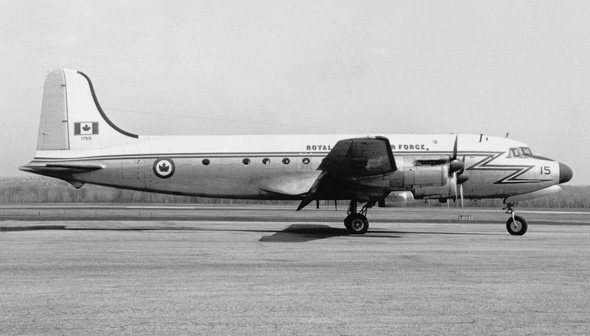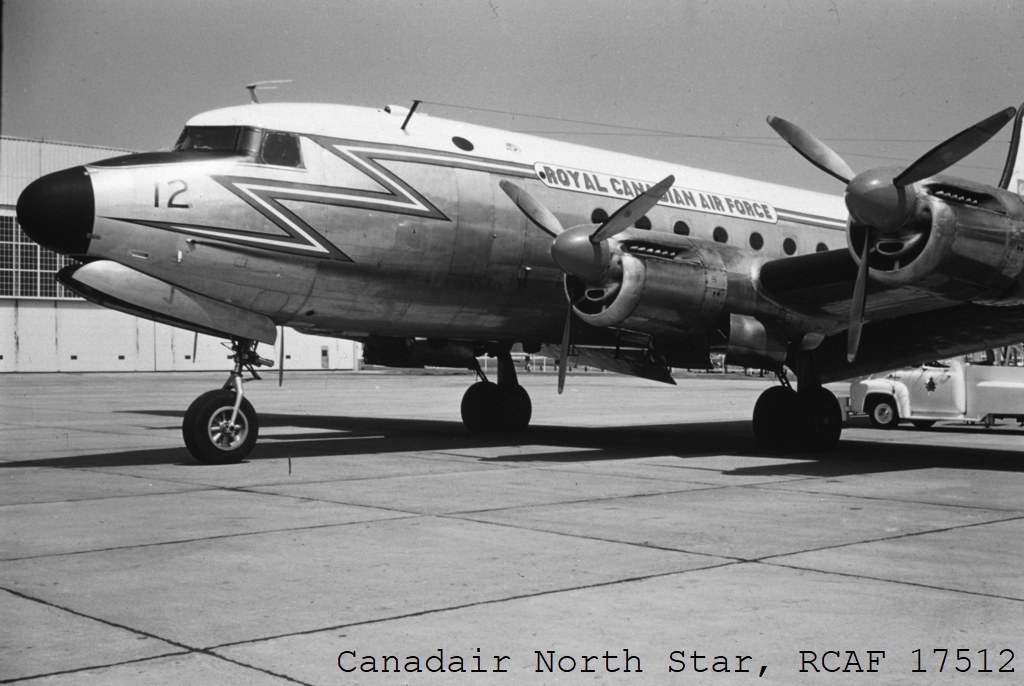North Star History
"The North Star turned Trans-Canada Airlines into a major world operator. It gave Canadian Pacific Airlines its opening into the international scene. For British Overseas Airways Corporation, where it was known as the Argonaut, it was a Godsend. And it gave the Royal Canadian Air Force a much-needed heavy transport for use on such big jobs as the Korean Air Lift"
James T. Bain
From the forward to The Canadair North Star (McGraw-Hill Ryerson, CANV, Toronto) by Larry Milberry.
RCAF North Star 17515

- Registration #: 17515 (RCAF)
- Manufacturer: Canadair Ltd., Canada
- Manufacture Date: 1948
- Construction #: 122
- Acquisition Date: 1966
- Provenance: Transfer from RCAF
At the end of World War II, Trans Canada Airlines had a requirement for a long-range transport for their overseas service. They had originally introduced this service with converted Lancaster bombers. The Canadian government decided Canadair, a new company formed in Montreal, should take up the challenge.
A variant of its American “cousins”, the Douglas C-54/DC-4 and DC-6, the North Star was equipped with four powerful 12-cylinder Rolls Royce Merlin engines. It came in two versions: one as an un-pressurized, noisy military version; the other as a pressurized, quieter civilian version.
From its first flight in July 15, 1946 it soon became know and admired worldwide. It was a commercial winner on both domestic and international routes with Trans Canada Airlines, Canadian Pacific Airlines, and served as the “Argonaut” in the British Overseas Airways Corporation.
The North Star served as a reliable and versatile workhorse for the Royal Canadian Air Force (RCAF). The museum’s unique specimen, RCAF registration 17515, was manufactured in 1948. Over the years, this aircraft was active in many vital roles including northern re-supply, research, training, humane relief operations, United Nations worldwide operations, support of Canada’s NATO operations in Europe, and in the famous and highly successful “Operation Hawk” airlift of supplies and personnel in the 1950-53 Korean War.
It served with 426 “Thunderbird” Squadron RCAF until 1962 when the squadron stood down and most of their aircraft were retired from service. A few North Stars were retained in RCAF service, including 17515. These were retired in 1965.
The 17515 North Star was acquired by the museum in 1966. A full-fledged conservation, restoration and preservation program was undertaken in 2003 and continues today with museum experts closely supervising a team of 20 enthusiastic volunteers … all proud members of Project North Star.
Specifications
- Wing Span: 35.8 m (117 ft 6 in)
- Length: 28.6 m (93 ft 9 1/2 in)
- Height: 8.4 m (27 ft 6 in)
- Weight, Empty: 19,730 kg (43,500 lb)
- Weight, Gross: 33,110 kg (73,000 lb)
- Cruising Speed: 325 mph (523 km/h)
- Max Speed: 568 km/h (353 mph)
- Rate of Climb: 296 m (972 ft) /min
- Service Ceiling: 10,970 m (36,000 ft)
- Range: 4,830 km (3,000 mi)
- Power Plant : 4 Rolls-Royce Merlin 622, 1760 hip, V12 engines
Further Information
For further information, see The Canadair North Star (McGraw-Hill Ryerson, CANV, Toronto) by Larry Milberry (252 pp. Photos diagrams, foldouts) ISBN 0-07-549965-7.
Canadair North Star C-54GM: Fact Sheet
Click the PDF icon to open, or right-click to download.
First Nonstop, Coast-to-Coast Flight in Canada

The First Nonstop Coast-to-Coast Flight across Canada was completed by RCAF North Star 17512 on January 15, 1949 as part of a fuel consumption test for the Experimental and Proving Establishment (E&PE) Station Rockcliffe. A fourteen man crew under the command of Flying Officer J.A. Jolicoeur, flew from Vancouver to Halifax 8hrs, 32min. A distance of 2785 miles was flown at an average speed of 329 mph.